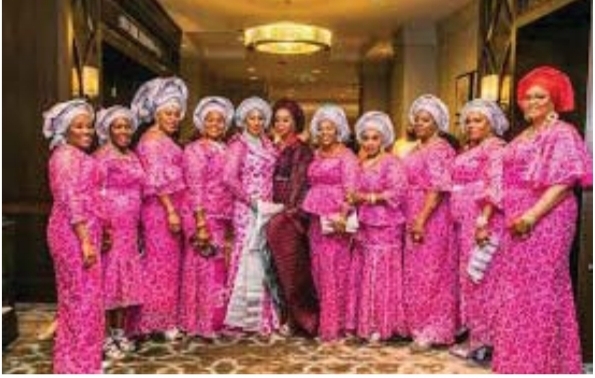
In today’s Nigeria—and indeed much of West Africa— no major celebration is considered complete without the colourful parade of Asọ-Ebi. Weddings, funerals, birthdays, anniversaries, and even child dedications are wrapped in the swirl of uniform fabrics, glittering head ties, and coordinated attires. What was once a symbol of communal solidarity has morphed into a multi-billion-naira social industry—and, for many, a financial burden masked in the language of tradition. At its origin, Asọ-Ebi—literally “family cloth”—was a noble Yoruba cultural practice.
It served as a visual marker of kinship and unity, helping guests at communal events identify themselves as part of the same extended family or supportive network. It was simple, dignified, and voluntary. But in contemporary times, Asọ-Ebi has shifted from solidarity to status display. The fabrics are no longer modest Ankara prints; they are now imported lace, George wrappers, or highend tulle net—some costing more than an average worker’s monthly salary. Tailoring charges are exorbitant, and the unspoken competition to “slay” on social media raises the stakes even higher. As one Lagos socialite bluntly confessed: “If your outfit doesn’t trend on Instagram, it’s like you didn’t attend the party. Asọ-Ebi is no longer about family—it’s about fashion.”
Today, Asọ-Ebi is as much a business as it is a cultural symbol. Hosts now compel friends, colleagues, and even acquaintances to “support” their event by purchasing the chosen fabric—often at inflated prices that include a hidden markup to fund the ceremony itself. Those who decline risk being labelled unsupportive or even socially ostracised. A fabric seller in Balogun Market proudly admitted: “During wedding season, I can make more than a civil servant earns in six months. People will buy anything as long as it is tagged Asọ-Ebi.” What was once a gesture of inclusion has become an economic obligation. It’s no longer enough to “show up”; one must “show up in uniform”—or be subtly sidelined in group photos and acknowledgments.
Some try to rationalise the high cost of Asọ-Ebi by claiming it “covers the sovernir” or “helps determine who gets a sovernir.” This argument is both logically weak and culturally tone-deaf. Souvenirs are gifts, not gatekept entitlements exchanged for fabric. A gift loses its meaning when it becomes a transaction. By tying Asọ-Ebi to the distribution of souvenirs, we effectively commodify goodwill and entrench classism at cultural events. Must the price of a keepsake be someone else’s kitchen budget? If we need a fabric roll to identify who deserves a plastic bowl or mug, perhaps what we lack is not cloth but clarity on what a celebration truly means.

Souvenirs should flow from gratitude, not from a guest’s wardrobe. Let us not insult generosity with this bartered benevolence. A celebration that punishes the ununiformed while rewarding the overdressed has lost the plot. Behind the glitz lies the quiet suffering of many ordinary Nigerians. Civil servants, teachers, and low-income earners are often pressured to buy multiple Asọ-Ebi in a single month, especially during peak “owambe” seasons. Some take loans to meet these social obligations. Others forfeit basic needs to avoid the embarrassment of being the “odd one out.” A schoolteacher in Ibadan lamented: “Last month alone, I bought three different Asọ-Ebi. By the time I paid for sewing, shoes, gele, and transport, my salary was gone. But if I didn’t buy it, they would say I was jealous.” This consumerist cycle deepens class divisions.
Those who can afford premium fabrics and celebrity tailors dominate the spotlight, while the less affluent fade into the background—or avoid the event altogether. The rise of Instagram culture has intensified the Asọ-Ebi frenzy. Parties are now staged as fashion runways, with event photographers and bloggers livestreaming outfits. Hashtags like #OwambeGoals and #SlayWithTheBridesmaids have turned what should be intimate cultural gatherings into public spectacles of wealth and curated beauty. Sociologists warn that this digital validation loop is distorting social values.
Instead of genuine celebration, events become competitions for “best dressed” and “most glamorous squad.” Perhaps the most jarring transformation is in funeral Asọ-Ebi. Traditionally, mourning was expressed in sober tones. But now, bereavement has its own colour codes—black and gold for parents, white and silver for elders, sometimes even wine and champagne hues for the young. Families of the deceased feel obliged to provide fabrics for “befitting” funerals, adding to the financial strain of grief. A widow recounted: “I was still crying for my husband when they asked me which Asọ-Ebi colour I would choose for the burial. I felt like the funeral became a fashion show instead of a time to pray for his soul.”
So why does the Asọ-Ebi phenomenon endure despite its clear burdens? Social pressure in communal societies makes nonconformity quickly noticed—and sometimes subtly punished by exclusion. Beyond that, there is an entire economic ecosystem built around it: tailors, fabric sellers, event planners, makeup artists, and photographers all thrive on the endless cycle, making reform difficult. Hosts use Asọ-Ebi sales as informal fundraising for their events. Guests use it to signal loyalty, inclusion, and relevance. And despite the excesses, it still offers a semblance of belonging in an increasingly fragmented world. This is not a call to abolish Asọ-Ebi. Culture is not static; it breathes and evolves.
Communal dressing can indeed foster unity. But like any good thing, it loses its soul when corrupted by excess. We must recover its original spirit of solidarity, not showmanship. Guests should feel free to attend in their own dignified attire without fear of ridicule. Contributions to events should be transparent, not disguised as compulsory fabric purchases. And perhaps most urgently, social media should be used to honour culture, not to inflate vanity. Asọ-Ebi can be beautiful. It can still symbolise love, unity, and shared joy.
But when it becomes a financial trap and a vanity contest, it strays from its roots. Culture is meant to lift people, not crush them; connect hearts, not empty wallets; express community, not enforce competition. Until we reclaim the original dignity of Asọ-Ebi, we will continue to host parties that glitter outwardly but quietly impoverish the very people they are meant to honour. So we must ask ourselves, boldly and honestly: Are we dressing for the event—or are we letting the event undress our values?
• Rev. Fr. (Dr.) Okhueleigbe Osemhantie Ãmos, Priest of the Catholic Diocese of Uromi and Lecturer at the Catholic Institute of West Africa, Port Harcourt, Nigeria.





